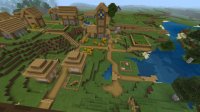A Guide to Teaching Writing With Minecraft
Using the popular game in station rotation activities during distance learning is a way to bring an element of play and collaboration to writing assignments.
In the book Lifelong Kindergarten, Mitch Resnick suggests that all of school should be like kindergarten. By this, he means that students should be invited to learn through what he calls the 4 Ps: projects, peers, passion, and play. Instead of projects that demonstrate what students have already learned (e.g., a diorama), students should learn in the process of making, sharing, and reflecting on artifacts.
Teachers can achieve the 4 Ps in physical classrooms through a station rotation model, as students visit stations with BrainPop or PBS LearningMedia videos, materials needed for project design, or other components.
Nowadays, station rotation models are somewhat limited by social and physical distancing measures, and it may be tempting to resort to direct instruction, but we mustn’t, because collaboration is so important in learning.
As it happens, there are innovative solutions to station rotation models in socially and physically distanced classrooms. Blended learning expert Catlin Tucker shares many approaches, mixing teacher-led stations with ones that are online and offline. In this arrangement, students can learn from the teacher and then share in small groups—virtually or distanced—and engage in online collaborations (e.g., via Google Slides).
Station Rotation in Minecraft
In the spirit of bringing in an element of play and peer collaboration, how would stations look if they were set up in a game world like Minecraft: Education Edition? In a conversation with Meenoo Rami, a senior program manager at Microsoft, high school teacher Joe Dillon and Christina Cantrill, associate director of national programs at the National Writing Project, discussed that question.
Dillon took ideas from that conversation and collaborated with writing teachers with experience in grades 3 to 8 to design some lessons. He built the worlds with the help of a colleague and student Minecraft enthusiasts, who brought a passion for the game and creative twists to the lessons that teachers had written and sketched. The worlds and the lessons within were playtested by young people engaged in the Denver Writing Project’s Young Writers Camp this past summer.
One of the lessons is an adaptation of Georgia Heard’s Six-Room-Poem activity. Last spring, Dillon consulted with teacher Marina Lombardo, whose students had just completed this activity as part of a remote learning poetry unit.
In the activity, students divide a sheet of paper into six parts or “rooms.” They then follow prompts for writing descriptive text in each room. When Dillon and Lombardo re-created the activity in Minecraft, students moved through a maze, visiting rooms with information on different aspects of poetry writing. As in the paper activity, the goal was to help students write or revise a poem.
The lesson cleverly aligns station rotation models in a digital game world. “Marina came up with the idea of taking a poetry writing lesson, which worked well in distance learning, to become a maze where students would discover different stations or the six concepts,” Dillon said when we spoke this fall. “Marina drew the maze on paper, and we handed that to a teenage builder I knew from the Writers Camp,” who built it in Minecraft.
There are prompts throughout the maze. Some are posted on digital chalkboards (blocks unique to the Education Edition), while others are “read” by non-playable characters (NPCs)—characters in the world that are not controlled by players. NPCs serve as docents, guiding students in a manner similar to the way teachers work in station rotation models in physical classrooms.
One of the messages from an NPC I encountered read, “As you travel through the maze, you will discover six rooms and meet friends. Each room is unique and will offer you some practice with ways to make your writing descriptive. You’ll want to have an object or an image in mind. Need inspiration? Take a picture inside the maze if you like. Then begin searching for the six rooms.”
Beneath the text were two options: “Camera please” and “Go to the first room.” The camera block, also unique to Education Edition, is a screenshot tool for exporting images out of the game. Students can build, then record and reflect on their work using this block.
Each of the 10 lessons Dillon and his collaborators created invites students to write and also to build. “The idea is that these are lessons that work without Minecraft first,” Dillon said. “Then, we put them into Minecraft.”
The lessons invite students to put their Minecraft skills to work. They can delve deeper into the lesson, rebuild the maze, or expand on the lesson. These opportunities seldom exist in physical classrooms, where teachers may design stations with little student input. With the Minecraft lessons, students can change the worlds, and teachers can, too. Each of these worlds can be played as they are, or remixed by teachers.
ELA lessons based on “This I Believe” exemplify this notion. In this world, students read mentor texts from the popular NPR essay series and then are invited to build objects representing their beliefs.
Teaching writing using Minecraft: Education Edition is a playful approach that aligns with Resnick’s 4 Ps—projects, peers, passion, and play. What’s more, it embeds the self-determination theory, the idea that students become motivated when they have a sense of autonomy, relatedness, and competence. Students are immersed in exploring a digital environment where they already may feel competent, and so have a sense of autonomy. These worlds are multiplayer, enabling students to feel like they are again in a community—pixels don’t require physical distancing.
